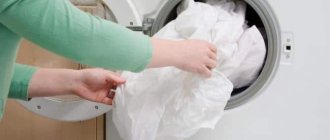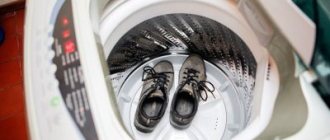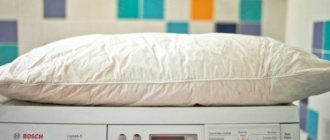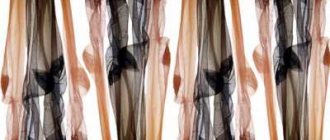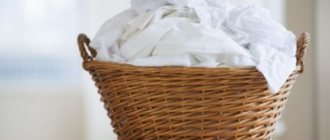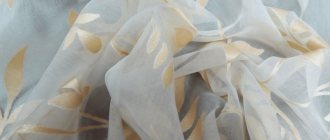How to wash curtains correctly? We will tell you how to properly clean curtains made from natural and synthetic materials from dirt and dust.
Every housewife knows how important it is that the curtains in the house are always clean, because most often they are the first to catch the eye of people who come. Usually, by this detail of the interior, visiting guests judge how clean the owner of the home is.
Therefore, if you do not want people who come into your house to have a not very pleasant impression of you, then regularly and most importantly, wash your curtains correctly.
How to properly wash curtains by hand?
Rules for hand washing
Although modern housewives do not really like to wash by hand, in the case of curtains they may still need this long-forgotten skill. After all, if your curtains are made of moire or silk, then machine washing can greatly damage their structure.
Such products do not withstand mechanical stress very well, so it will be better if you carefully remove dust from them and simply rinse them in soapy water.
Hand washing rules:
- Wash curtains in as much water as possible. If you put a large curtain in a small container, this will not allow you to effectively get rid of dirt
- Before the main washing process, be sure to vacuum the curtains using a soft-bristled brush, and then soak them in a soapy solution for at least a couple of hours.
- Never pour powder directly onto curtains. Such actions will not allow you to rinse them well and as a result, after drying, streaks may remain on the curtains
- It is also not advisable to wring out the curtains. A very strong mechanical impact can stretch the fabric threads and this will lead to deformation of the product.
How to dry properly
Under no circumstances should linen products be dried in direct sunlight, especially for colored items. The sun will very quickly destroy the structure of the fabric and its color will no longer be so bright and attractive, and the linen will begin to look untidy. Hanging the straightened product in a well-ventilated area or outside will help remove excess water.
Never wring or twist a wet cloth, as this will cause unpleasant consequences. Until the product is dry, no further actions can be carried out with it. However, you need to remove it while it is still slightly damp. When drying jackets and shirts, be sure to use hangers to prevent the fabric from losing its shape.
Linen product
How to wash curtains in a washing machine, on what mode?
Rules for washing in a machine
An automatic machine makes life much easier for housewives, because they do not have to stand and manually wash clothes and household items for hours. But sometimes, a seemingly banal washing of curtains ends with a rather disastrous result.
Most often this happens due to the fact that women do not select the washing mode correctly. If you want to avoid such problems, then always wash your curtains on a delicate cycle at a temperature of 30-40 degrees.
Machine washing instructions:
- Never overload the drum. This will lead to a decrease in the quality of washing and may also damage the curtains themselves.
- Before washing, be sure to sort your curtains by color and fabric type. If you want to achieve perfect cleanliness, then always wash curtains made from natural and synthetic materials separately.
- Use liquid laundry detergents. They dissolve faster and are better rinsed from fabrics
- If you decide to use regular powder, then first dilute it with water and add it in liquid form to the machine.
- If the curtains are very dirty, then first rinse them in a bowl of soapy water and only then put them in the drum of the machine
Material characteristics
Thick linen fabric is available unbleached, fully or partially bleached, printed or plain dyed. Often the material is made from threads dyed in different shades, which allows you to get a variety of patterns - checks, stripes, jacquard.
Linen fabric comes in several types depending on the weave of the threads:
- twill;
- jacquard - used in the manufacture of napkins, curtains, tablecloths, suits and dresses;
- linen;
- openwork - used for sewing light blouses, dresses, curtains;
- large patterned;
- finely patterned.
In Italy, Ireland, and Belgium, expensive, elite linen fabrics are produced, from which clothing, tablecloths, towels, curtains, napkins and bed linen are made.
Linen fabric from domestic manufacturers is much cheaper. When added with lavsan or other synthetic fibers, it is inexpensive, while characterized by increased wear resistance and strength. In appearance, blended linen fabric cannot be distinguished from completely natural material.
Semi-linen fabric, consisting of flax and cotton, is very popular among consumers. This is explained by its absolutely natural composition, low cost and optimal density.
There are several classifications of linen fabric used for sewing curtains. The most popular of them are:
- By relief and texture. Most often, embossed options are used for curtains. Smooth fabrics are most often used as furniture upholstery.
- By color. There is bleached, unbleached and colored fabric.
- By density. There are dense fabrics with a textured surface and lightweight options with a smooth surface.
- By purity (composition). Pure flax fabric is quite difficult to care for due to its significant susceptibility to creasing. Fabrics with the addition of synthetic fibers are also produced, which retain all the advantages of natural material, but lack the disadvantages.
Linen tulle is a separate group. It is distinguished by its extraordinary lightness, transparency, unique relief and, as a rule, has a delicate, beige color. In addition, it combines perfectly with different materials that are used to make curtains.
Linen has many faces; curtains, curtains, lambrequins, and roller blinds are made from it.
How to wash roller blinds on plastic windows?
We wash roller blinds
When buying roller blinds for plastic windows, always check what material they are made of. If they are made from material that has been treated with dirt-repellent impregnation, then you will not need to wash them in the literal sense of the word.
If you vacuum them at least once a week, they will not need wet cleaning for at least three months.
Recommendations for washing roller blinds for plastic windows:
- Heat the water slightly and dissolve any liquid powder in it.
- Beat it all into a stable foam and apply it to the roller blinds using a sponge or soft cloth.
- Using light movements, spoil the curtain, and then using another rag soaked in clean water, carefully remove any remaining detergent from the surface
How to wash fabric roller blinds?
Putting fabric roller blinds in order
Unlike the previous ones, this type of roller blinds is more convenient to use, so housewives can wash them in a more traditional way. In this case, it will be easier for you to wash the curtains as you can remove them from the window and wash them in the bathtub or large basin.
So:
- Fill the bath with some water and dissolve any detergent in it
- Remove the roller blinds from the window and carefully immerse them in the soapy solution.
- Then take a sponge or soft-bristled brush and rub the surface of the product in smooth circular motions
- If after this procedure there are still stains on the curtains, then try to get rid of them using special products made on a natural basis
- At the end, be sure to rinse the curtain fabric as thoroughly as possible in clean, slightly warmed water.
- Let them drain a little and then dry on as flat a surface as possible.
Digestion
If washing the tulle did not help cope with yellowing, grandmothers and mothers boiled the curtains:
- they took a large enamel basin or bucket;
- water was poured into the container, soap shavings or powder were poured in;
- the product was placed into the liquid foam mixture;
- the container was placed on fire;
- after boiling, heated for an hour over medium heat, turning occasionally (the material was grabbed with metal tongs).
Curtains made from cotton fibers will become snow-white again after boiling.
Modern types of textiles add artificial fibers that require careful care. With prolonged boiling, delicate threads quickly melt and the fibers become deformed. Curtains made of organza, chiffon or nylon cannot be boiled. Curtains made from thick natural fabrics are sometimes boiled down, although the housewife has to control the process and should not leave the stove often.
Reference! If cotton textiles have turned yellow and dirty, the item is first boiled and then soaked in peroxide. If the dirty color remains, the fabric is kept in salted liquid, then rinsed and starched. Often this method should not be used: after 2–3 treatments, the fabric will become thinner and irrevocably lose its snow-white color.
How to wash Roman blinds?
Cleaning Roman curtains from dirt
I would like to say right away that although Roman curtains can be washed in a machine, this process should be used extremely rarely. Such products do not really like strong mechanical impact, so if possible, get them in order by dry cleaning.
Rules for washing Roman blinds:
- First, remove the curtains from the window and carefully remove the slats that are inside the fabric.
- Heat the water (it should not be very hot) and add the powder to it
- The detergent that you will use to wash curtains should be as gentle as possible and, if possible, with a neutral Ph
- Soak the curtains in soapy water and leave them in it for about an hour.
- Then do a standard hand wash and rinse them in clean water at least 2 times
How to make tulle white using improvised means
Ordinary substances will help restore lost whiteness. Such products are hypoallergenic, effective, and affordable.
Salt
The use of these products requires soaking.
To cleanse dirt and bleach, tulle curtains are soaked in dissolved sodium chloride (for 5 liters - ¼ cup each of washing gel and salt). After 8-10 hours, rinse and wash using the usual method.
Additional Information! If you soak very dirty curtains twice (the first time in dissolved sodium chloride, the second time you add gel), you will be able to wash off even old grease.
Aspirin
The gray coating will disappear from the fabric after soaking in dissolved aspirin (take 5 tablets for 6 liters of lukewarm water). The textiles are cleaned of dust, placed in a basin, and filled with washing liquid. After 3 hours, wash.
Soda
An alkaline solution easily removes dirt and restores the original color of even old fabric. To prepare the detergent composition, stir 30 g of sodium bicarbonate and the same amount of powder into 10 liters. An hour after soaking, the curtains are washed in a machine or by hand. Curtains made of linen or cotton are treated with soda ash, veil, organza, chiffon - only food grade.
Reference! Remove the dirty gray coating and bleach the tulle with a mixture of salt and soda: take 7 tbsp for 10 liters. spoons of alkali, 9 tbsp. spoons of rock salt. The curtains, cleaned of dust, are kept in the prepared composition for 1.5 hours, then washed thoroughly. Wash with gel or soap.
Boric acid
Folk remedies will help remove grayness and yellowness.
The drug can bleach old nylon tulle, covered with a gray coating and yellow spots. It is easy to verify the effectiveness of the method; to do this, follow these steps:
- 30 ml of boric acid is diluted in five liters of warm liquid;
- curtains are soaked for 3 hours;
- rinse.
The product, which has regained its lost snow-whiteness, is straightened. Dry in a shaded place.
Useful to know, we recommend reading: What to do if a mercury thermometer breaks at home and mercury leaks out?
Vinegar
Table vinegar removes grayness and eliminates unpleasant odors embedded in the fibers. The curtains are dipped in a lukewarm salt-vinegar solution for 3 hours (the ingredients are taken in equal parts), then washed and dried.
Ammonia
Before bleaching tulle curtains with ammonia, the item is washed and then immersed in an unsaturated ammonia solution for 1.5 hours. After bleaching, rinse.
Additional Information! If dirt has become embedded in the thin fibers, ammonia is combined with 30 ml of hydrogen peroxide. In this way, soot and grease are quickly removed, and even old tulle that hangs in the kitchen is lightened.
Lemon acid
Dry matter or juice is added during the final rinse. Before this, the curtains are cleaned with white soap and lightened with peroxide. The washed curtains are kept in dissolved citric acid. After 15 minutes, carefully squeeze out without twisting.
Citric acid whitens and removes rust marks
Hydrogen peroxide
Hydrogen peroxide is a strong bleach that helps restore the whiteness of delicate tulle items. The curtain is placed in a capacious container, filled with diluted clarifier (4 tablespoons of the drug are used for 12 liters). After 4 hours, rinse.
Potassium permangantsovka
Restore the snow-white shade, remove stains and stains with a pale pink solution of potassium permanganate. The crystals are diluted in a transparent container and combined with shavings of light laundry soap. Stir and pour into a bowl of warm water. The curtains are soaked in foamy liquid for 3 - 4 hours.
Blue
Contaminated tulle can be cleaned in a washing machine or by hand. The washed curtain is placed in diluted blue for 25 - 30 minutes to remove the gray-yellow coating. The new soft blue shade will give the item an updated look.
Reference! When using dyes - blue, brilliant green - follow the dosage recommended by the manufacturer, monitor the saturation of the liquid, otherwise the curtains will acquire an undesirable color.
Zelenka
The yellowness will disappear from nylon and tulle after soaking in a saline solution with brilliant green. A bleaching agent is prepared from the following components:
- 0.5 liters of water;
- 4 table. spoons of salt;
- 20 drops of greenery.
The ingredients are thoroughly mixed, then diluted with water. The pre-washed curtain is immersed in a liquid greenish composition. After 15 minutes, the item is hung on a rope.
Laundry soap
Light laundry soap will return the yellowed product to its purity and snow-white tone. To do this, pour 0.1 kg of washing powder and 0.15 kg of soap shavings into a basin of heated water. The components are stirred until completely dissolved. The textiles are kept in the liquid mixture for 2 hours, turning occasionally. After treatment, wash. The final stage of cleaning is a gentle machine wash.
Additional Information! Curtains made from artificial fibers should not be cleaned with soap: the fabric irrevocably loses its shine.
Wash only with white soap
Starch
Starched curtains look elegant. Starch enhances the density of natural materials and repels dust particles. To make the fabric on the window gather into elegant folds, make a weak paste:
- First, the dry substance is dissolved and put on fire.
- Stirring constantly, bring to a boil.
- The boiling paste is poured into cold water.
- Breaks up lumps.
- The canvas is immersed in the prepared paste. They wait for the material to be thoroughly saturated with starch.
- Lightly squeeze and dry.
Wet curtains are carefully ironed.
How to wash curtains with eyelets?
Recommendations for washing curtains with eyelets
If you want curtains with eyelets to last you as long as possible, then buy products made from the highest quality materials. In such curtains, the eyelets play an important role. Very often the durability of products depends on their quality.
Correct products should not rust, fade or become deformed. If you don't want to draw, then buy curtains with plastic eyelets. They cost much less than iron ones and the best part is that they are quite easy to remove.
Recommendations for washing curtains with eyelets:
- Use a vacuum cleaner to remove dust from the curtains and remove them from the curtain rod.
- If possible, be sure to remove the eyelets
- Prepare a solution with dense foam from warm water and liquid powder
- Dip the curtains in it and let them lie in the water for literally 15 minutes
- After this time, carefully wash the curtains and rinse them in clean water
- If they are made from wrinkleable material, then wring them out and dry them as usual.
- If they are made of wrinkle-resistant fabric, let them drain, attach the eyelets in place and return them to the window while still wet.
General rules
- Before washing, be sure to find out the type of fabric and follow the specific recommendations for it.
Study the label on the material, which indicates the washing temperature and the possibility of using chemical bleaches - It is better to take expensive curtains to dry cleaning immediately. It doesn't cost that much.
- The material should not be cleaned too often. Only as needed - when dust accumulates, flames will appear.
Dry cleaning is always less harmful to any fabric than washing. Therefore, it is better to vacuum curtains more often than to wash them.
How often should I wash curtains?
Wash curtains as they become dirty
- If you ask a similar question to different women, you are unlikely to get a definite answer. An inveterate cleaner will say that curtains need to be washed every two weeks, but a woman is always busy, that it can be done once every six months. And oddly enough, in the case of curtains, both ladies can be on the right
- The regularity of washing curtains usually depends on where they are placed. If they hang on the kitchen window, which is open almost all day, then it is likely that they will have to be washed every two weeks. But if the curtains hang, for example, in the living room, then you can wash them even once six months
- Also, the regularity of washing can be affected by the presence of stains that are difficult to remove. Since they cannot be gotten rid of by dry cleaning, the housewife will have no choice but to remove the curtains and wash them
- In addition, it is worth considering what time of year it is outside the window. In summer and spring, when there is a lot of dust outside, you need to wash the curtains every 2-3 minutes. With the onset of cold and dampness, this time period can increase from 4 to 5 months
How to wash thread curtains?
Curtains made from threads must be washed in a special bag.
Thread curtains are a cascade of woven threads securely attached to a fairly thick braid. It is clear that it is unlikely to be possible to wash such a product in a standard way. If you just put it in a basin and start pressing it with your hands, you will simply tangle the threads and eventually you will have to throw out your curtains.
Therefore, if you want to protect yourself from such problems, then try to fix the threads as well as possible and only then send the curtains to the wash.
So:
- Braid the curtain threads and remove them from the curtain rod
- Shake the product lightly (this will partially get rid of dust), and then put it in a bag and tie it well
- Send this workpiece to the drum of the machine and add any liquid powder to a special tray
- Set the temperature to 30 degrees, delicate wash mode and press the start button
- In this case, it is better to refuse machine spinning and let the curtains drain naturally
How to make fabric turn white using household chemicals
Most older generation bleaches contain chlorine. This element disinfects and brightens quickly, but aggressively - along with the yellowness, the structure of the fibers is destroyed. Such products should be used rarely, only for dense natural materials. To care for a veil, cambric, jacquard, choose chlorine-free compounds that act gently:
- Oxygen preparations containing sodium bicarbonate, hydrogen peroxide. When interacting with water, they release oxygen. Eliminate dirt, foreign odors and quickly exhibit whitening properties without disturbing the structure of the threads. The grayish-yellow coating returns after 2 - 3 weeks, but such compositions can be used regularly for washing curtains.
- Synthetic and natural materials are treated with optical brighteners. Powders remove dirt and lighten dark stains. Reflective microparticles do not eliminate, but hide the gray-yellow coating, so the curtains appear snow-white for 3-4 weeks.
Before washing the tulle, dissolve the detergent according to the instructions. Chemical mixtures act intensively even in cool water. Textiles are placed in the prepared bleaching medium. If using a machine, the clarifier and powder are poured into a special compartment. The washed item is rinsed and hung out to dry.
White
The clarifier is 95% chlorine. Causes allergic reactions. When working, wear gloves and open windows. The active ingredient removes yellowish circles, destroys dirty gray tint, and disinfects at +30℃. It is used for the care of linen and cotton curtains, for cleaning organza; muslin is not used, because the aggressive element thins the threads. Leave the curtains in the diluted mixture for 30 minutes before final cleaning.
Whiteness destroys delicate fabrics
Additional Information! After 1 – 2 soakings in “Whiteness”, the matter gets used to the active component and stops reacting to oxygen bleaches.
Wellery delicate white washing gel
Gently lightens cotton and synthetic fabrics. Contains optical brightening microparticles and enzymes. The hypoallergenic gel returns the snow-white appearance of curtains using any cleaning method, although it cannot cope with old dark stains, stubborn dirt and grayness. Dissolves in hot and cold water. Smells nice. Easily washed out.
Chirton oxygen bleach stain remover
Fragrant particles cleanse dirt and remove even old stains from berries, soot, and grease on curtains made of cotton and synthetic fabric. Chirton oxygen is considered one of the best effective drugs that restore the lost snow-whiteness of canvases. Enhances the effectiveness of gels. Intensively whitens at any temperature.
Other means
Similar preparations are used to bleach tulle curtains.
Bleaching preparations are selected for delicate threads
Frau Schmidt
Whitening tablets are designed for the care of delicate textiles. The packaging is designed for 5 wet treatments. Optical and oxygen-containing elements, enzymes destroy stubborn dirty stains even in hard and cool (+30℃) water. Does not cause allergies.
Cashmere
Small granules with optical brightening microparticles for the care of delicate natural and artificial fabrics. The yellowed fabric is soaked and cleaned in a warm solution. Removes nicotine film and yellowed greasy stains. Removes gray plaque from kitchen curtains.
Dr. Beckmann
Oxygen-containing sachets for machine cleaning of cotton and artificial fibers. The concentrated substance whitens, eliminates foreign odors, removes dust, soot and greasy stains at +20℃. Effectiveness increases when heated. Portion bags (0.08 g) are placed together with the item in the machine drum.
Optical brighteners are used for silk
Freshbubble
Oxygen stain remover with brightening properties. Without boiling, it removes contaminants of natural and inorganic origin. The granules do not contain chlorine. Effectiveness increases at temperatures from +50℃.
Splash
An oxygen-containing brightener with optical elements designed for wet processing of delicate curtains made of nylon, cotton and linen. Splash is conveniently packaged in 30 gram bags. The packaging is designed for one use. Pre-washed curtains are immersed in dissolved powder for 0.5 hours, then rinsed thoroughly.
Clean home
Oxygen microgranules with an optical brightening component are used for soaking and washing. One spoon of small granules eliminates fresh streaks and bright stains. To wash away old circles, double the dose.
Reference! Silk curtains are treated with special powders: Laska 3D wool and silk, Unipuls, Organic People.
How to wash filament curtains with glass beads?
Tidying up curtains with bugles
Bugles are nothing more than glass beads strung on threads, so you don’t even need to think about machine washing in this case. Since the glass will hit the walls of the drum during washing, no matter how securely you fasten the threads, the likelihood of their damage will still not go away.
For this reason, curtains with glass beads should be washed exclusively by hand.
Basic washing rules:
- Tie the threads with thick braid and remove them from the window
- Heat the water and dissolve the washing powder in it
- Dip the curtains in the mild solution and gently scrub them with a sponge or brush
- Drain the dirty water and rinse the product under running water
- Let it drain completely and return it to the ledge
How to wash blackout curtains?
Cleaning light-proof curtains
Light-proof curtains are among those products that are not afraid of either hand or machine washing. The only thing you should consider is their color. If your curtains are quite dark in color, then do not use powders with a bleaching effect to clean them.
Rules for washing blackout curtains:
- Remove the curtains from the window and shake out any excess dust.
- Put them in the machine and set it to delicate mode at a temperature of 40 degrees
- After washing, dry them in the fresh air, then iron and return to the rack
- If your product is not allowed to be ironed, then do not wait until it dries, but return it directly to the window while wet.
How to wash polyester curtains?
Washing polyester curtains
- Polyester curtains are characterized by fairly high strength and resistance to fading. Housewives love them for their unpretentiousness and ease of care. Quite strong threads allow them to be washed both by hand and in a machine.
- But the best part is that even without spinning, they dry literally within half an hour. The only disadvantage of these products is their intolerance to high temperatures. Therefore, during washing, you need to make sure that the water readings do not exceed 40 degrees, because if the water warms up even a little, then folds will appear on the curtains, which will be impossible to get rid of
- If you want your curtains to last you as long as possible, then try not to twist them, just let them drain in the washbasin and only then move them out into the fresh air
How to wash white curtains?
Tidying up white curtains
- White curtains have one unpleasant feature: over time they inevitably begin to turn yellow. For this reason, before washing, they must first be lightly bleached. In principle, you can quite easily use bleaching agents for these purposes.
- They quite effectively return the whiteness to fabrics. But due to the large number of aggressive substances in the composition, they cannot be used very often. Common table salt will help you replace industrial bleaching agents.
- If you add it to water (for each liter of liquid you need to add 1 tablespoon) and soak the curtains in this solution, then after washing they will return to their pure white color
Washing recommendations:
- Remove the curtains from the curtain rod and shake out the dust.
- Soak them in saline solution for 2-4 hours
- After this time, remove the curtains from the basin, fold them into a neat rectangle and place them in the machine drum
- Add gel for whites to the washing machine, set it to hand wash mode and turn on the machine
- After finishing washing, put the product in salt water again, but this time limit it to 1 hour
- Then gently wring them out and dry them in the fresh air.
Modern remedies for grayness and yellowness
Several types of bleaches are suitable for curtains:
Chlorine-based bleaches have been used for a long time. This group includes the common remedy Whiteness. Such substances act quickly, but give short-lived results. Chlorine quickly destroys the structure of the fabric, the threads become thinner, and yellowness quickly returns.
Oxygen bleaches (for example, Vanish) clean much more gently. They do not damage the structure of the material. You can easily use them more often than chlorine-containing analogues. However, substances such as stain removers are marketed. To properly bleach gray textiles, follow the instructions.
The procedure is carried out by hand washing; it is often necessary to soak the item in the prepared solution or apply the substance directly to the material. Among the disadvantages of oxygen bleaches is their short duration of action. After just a few washes, you will have to look again for methods to rid tulle of grayness.
Optical brighteners return whiteness to things or enhance the brightness of white fabrics due to their ability to absorb ultraviolet radiation in the range of 300-400 mm. The rays are converted into light with a blue tint, the wavelength is 400-500 mmk. The perception of once gray things changes due to compensation for the deficiency of blue rays. The technology is suitable for natural and synthetic materials.
Is it possible to boil curtains?
You can only boil curtains made from natural fabrics.
- Boiling is the oldest method of bleaching things. Our grandmothers boiled towels, white clothes and, of course, curtains in a large basin about once a month. But if earlier women did this without fear, then modern housewives are not unequivocal about this method
- Nowadays it is very difficult to find curtains made from completely natural fabrics. Usually, even if the label says that they are natural, at least 5% of artificial threads are still present in it
- For this reason, women do not want to take risks and prefer modern whitening media. But still, if you are sure that your curtains are made, for example, from cotton or linen, then you can safely boil them
How to wash organza curtains?
Washing organza curtains
Organza is a rather thin and delicate material, so it must be washed as delicately as possible. It will be better if you do this with your hands using gentle detergents. Also keep in mind that washing should take place practically without any mechanical impact.
You can achieve good results by doing the following:
- Heat the water to 30 degrees and dissolve the washing powder in it
- Soak the curtains in this liquid and leave them in it for half an hour
- Then drain the dirty water, prepare the soap solution again and put the organza curtains in it
- Repeat the soaking procedure until the water becomes clear
- After this, rinse the curtains in warm water and let the excess water drain off
If the fabric of the product becomes very wrinkled during washing, then iron it with an iron with a vertical steamer or carry out the procedure in the standard way, just put a piece of cotton fabric on the curtains
Methods for bleaching tulle from different types of fabrics
Various means are used, taking into account the composition of the material. Individual methods are often used for synthetic and natural fabrics. This is due to the structure of the material.
Organza
The fabric is characterized by moderate rigidity. This is a transparent material, it is made from various raw materials: polyester, silk, viscose. The main difference is the technique of weaving the threads. Organza is washed at a temperature not higher than +40°C. A higher temperature will cause a change in structure. To whiten organza tulle that has turned yellow or darkened from soot and soot, you can consider the following remedies:
Not all folk remedies bleach such material; some of them act aggressively and therefore cannot be used. Organza cannot be twisted. For the same reason, use a delicate wash program, without spinning.
How to bleach nylon tulle?
Recommendations for caring for nylon are the same as for the option discussed above: do not use hot water and aggressive agents, it is better to avoid squeezing. The optimal temperature regime is up to +30°C. The material can be washed by hand. If the automatic machine’s functions do not include a “delicate spin” mode, it is permissible to set the speed to 400 rpm.
To whiten white nylon tulle, you can take home remedies to get rid of yellowness:
- Saline solution: 10 liters of water, 1 cup of salt. You need to soak the material.
- A product based on blue or brilliant green: prepare a weak solution.
- You can bleach dirty tulle using potassium permanganate: take a small amount of fractions and 3 liters of water, it is important to get a slightly pink substance. To this product you need to add laundry soap, which is pre-crushed (1/2 briquette), the mixture needs to be shaken by hand until foam forms. The nylon is left for 30 minutes.
After soaking the nylon, you can proceed to the second stage - washing in an automatic machine or manually.
Tulle veil
If you are looking for ways to bleach such material, you should consider recipes based on soap, salt, starch, soda, blue, and brilliant green. Tulle is a mesh with patterned weaving. In production, polyester is used, much less often - silk threads. Such material is easy to damage, so it is better to do without squeezing. Recommended temperature within +30…+40°С.
Chiffon curtains
They are characterized by low strength, so you cannot use the spin washing mode. You can bleach chiffon with laundry soap and salt. Washing is done in cool water. To prevent grains from damaging the material, the salt must be fine-grained.
Linen tulle
It is acceptable to use ready-made bleaches. However, it is recommended to use them as rarely as possible. This is due to the aggressive action of such agents. You can refresh linen curtains with a solution based on ammonia. This is a suitable product for natural materials.
Batiste
Tulle is a type of cotton fabric that is resistant to high temperatures. This type of tulle can be washed and bleached by boiling it with laundry soap, as well as a solution based on starch, ammonia and hydrogen peroxide.
Kiseya
Kisey is a cotton material (made from cotton, but it is distinguished by a non-standard weaving technique), you can use the same bleaching methods as for cambric (ammonia-based solution). When washing, only powder is used, without additives. The bleach is used separately, before or after removing stains from the fabric.
Mesh (tulle)
Tulle is moderately durable and is made from synthetic fiber (polyester thread). Tulle can withstand the effects of more aggressive agents, but they should not be abused for the same reasons: the fabric quickly loses strength. A good solution for the mesh would be a saline solution in combination with washing powder. It is necessary to soak the product for a while until improvements are visible. Then you can simply rinse it.
How to wash linen curtains?
Tips for cleaning linen curtains
Linen curtains are considered the most unpretentious, so they tolerate both manual and machine washing. The only thing they don't like is chlorine. If you use chlorine-containing detergents for washing, they will quickly thin out the threads of linen curtains, and they will simply tear.
Therefore, if you need to bleach such products, then use modern oxygen bleach for this. It will refresh the color of curtains just as well as chlorine, but will do it without compromising their appearance.
Simple tips:
- You can wash linen curtains in a machine, but this must be done in hand wash mode and at a temperature of 35 degrees
- Hand washing should also be done at gentle temperatures.
- In this case, the powder can be replaced with laundry soap
- If you will use a stain remover, then first test it somewhere in the corner and only then apply it to the stains
- There is no need to wring out linen curtains. This will cause them to become very wrinkled.
- Also, be very careful that they do not dry out; if you remove them from the rope completely dry, you will spend a lot of time ironing
Proper ironing
You need to iron things while they are still a little damp, so that when exposed to hot steam, the surface does not dry out. If you process a completely dry product, then it will be quite problematic to smooth out absolutely all the folds.
Expert opinion
Irina. Housewife.
Ask a Question
Colored items are usually ironed on the wrong side. And if this rule is not very important for light-colored items, then dark-colored items need to be ironed exclusively from the inside out. If you neglect this advice, ugly marks may remain on such things, which will definitely not be removed by anything later.
How to wash nylon curtains?
Washing nylon curtains
- Nylon has not gone out of fashion for quite a long time, but it, like tulle, quickly loses its whiteness. Proper washing can help you avoid such problems.
- If you do not wait until yellowness appears on the curtains, and at least sometimes add oxygen bleach to the washing water, then the curtains will delight you with their ideal appearance for a very long time. If you have already missed the right moment, then try first soaking the nylon curtains in bleach and only then start washing them
- Yes, and do not forget that it is best to wash such curtains with bleaching powder. Moreover, if the products are very dirty, then you can add it 2 times more than usual
How to wash Japanese curtains?
Cleaning Japanese curtains
- If you own real Japanese curtains, then you probably know how delicate they are. They are made of the thinnest material, which seems likely to tear at the slightest stress. It is clear that you need to behave with such a product very delicately
- If you want your Japanese blinders to please you for as long as possible, then do not be lazy and remove dust from their surface with a vacuum cleaner at least once a week. Such curtains need to be washed 3-4 times a year. This is best done by hand, but if you are very busy, then you can use a machine for this.
- Just wash them on a delicate cycle and skip the automatic spin cycle. After the machine stops, remove them from the drum and carefully hang them over the bathtub and let the water drain
How to carefully bleach old tulle from gray stains and yellowness?
In old curtains, dirt managed to penetrate deep into the structure of the threads and became ingrained under the influence of high temperatures (for example, curtains in the kitchen). Removing them will not be easy. It is also difficult to bleach old yellowed tulle due to significant damage to the fibers. The fabric can tear at any time during intensive washing. Instructions for removing yellowness:
- First, the curtains are washed by hand or in an automatic machine. Choose a delicate mode, without spinning.
- If the fabric can withstand high temperatures, you can improve the result by using the boiling method with laundry soap.
- The tulle is soaked in a solution based on ammonia and hydrogen peroxide.
- You can bleach sun-bleached kitchen tulle with salt. There is no need to soak the product.
- The material is rinsed in a starch-based solution.
How to wash satin curtains?
Tidying up satin curtains
- Satin curtains are distinguished by their special sophistication and grace. They make a simple interior rich and stylish. But such fabric is quite impractical and even raindrops leave stains on it. But still, some housewives take risks and hang curtains made from this material on their windows
- Usually, when it comes to washing, such women are a little lost and do not know how to properly tidy up their satin curtains. Most often, such curtains, in addition to dirt and dust, have quite a lot of stains of different sizes. Therefore, before you start washing, you must definitely get rid of them.
- You can do this in any way convenient for you. You can use dishwashing detergent for this (if the stains are greasy) or treat the stained areas with a stain remover for colored fabrics. After this problem is over, you can clean the curtains from dirt in the machine in hand wash mode
How to starch curtains: do it quickly, efficiently
Significantly prolong the purity of the product, bring a feeling of celebration into the house, give clarity to the design - all this can be done with the help of ordinary starch. Starching makes the material stronger and denser. With this procedure, the canvas holds its shape longer, does not wrinkle, and gets dirty less. How to starch tulle? Let's look at the process step by step.
A starched curtain looks fresh, elegant and festive
Preparation
Before the procedure itself, the curtain must be prepared: washed, bleached. To do this, you should use approved home or chemical remedies.
You can wash tulle by hand or in a machine, it all depends on the type of fabric
Selecting a processing method
There are three options:
- The soft way.
- Average.
- Hard.
Each method requires its own amount of starch. A soft method is suitable for processing tulles. To do this, you need to prepare one teaspoon of starch, a liter of warm water.
It makes no difference what kind of starch you use, but corn starch is much softer than potato starch and dissolves better in cold water
Soaking in solution
This is the last stage. To prepare the solution, place only one teaspoon of starch in a liter of warm water.
It is important to brew starch in the correct proportion
The liquid must be boiled until a paste forms. After this, it needs to be given time to cool and strain thoroughly. The cold solution should be poured into a basin, and a curtain should be placed there. Soak should be about thirty minutes. Afterwards the tulle can be taken out and dried.
After soaking in a starch solution, do not twist the tulle, but simply shake it and hang it to dry well straightened.
How to wash velvet curtains?
If you can't decide how to wash velvet curtains, then just look at the base they are made from. If there are a lot of synthetic threads in it, then put them in order in an automatic machine. If the base is made of natural fabric, limit yourself to hand washing.
Rules for washing velvet curtains:
- Water temperature should not exceed 30 degrees
- It is forbidden to squeeze velvet products in a centrifuge.
- Velvet curtains can only be dried completely straightened out.
- If you want to get rid of water faster, then wrap the curtains in a clean terry towel and twist it lightly
